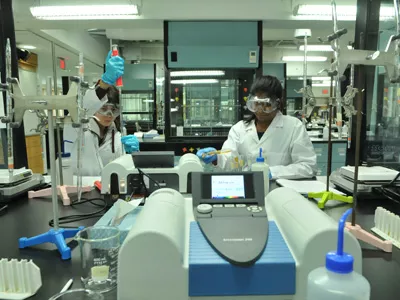
Chemistry labs receive update, roomy quarters, leading edge equipment
In a race against time, a team of designers and construction experts had less than five months to completely renovate the chemistry undergraduate teaching labs -every mechanical, electrical and plumbing system, plus the instrumentation. Deserving of its own reality TV show, the newly renovated labs in the William G. Davis Building welcomed their first students in September. The state-of-the-art facilities have garnered rave reviews and promise to be a showpiece for recruiting new students.
The $6 million renovation was undertaken because the antiquated labs, dating from the early 1970s, had become a health and safety hazard, says Mylène Vincent, manager of the Department of Chemical & Physical Sciences. "The standards for safety have changed drastically since then," she adds.
"In the old days, 40 years ago, chemistry students did much of their work on a lab bench outside a fume hood," says chemistry chair Peter Macdonald. Because chemists work with toxic, explosive and carcinogenic compounds, all reactions nowadays are carried out under safe conditions in a fume hood, an enclosed box with a powerful vent fan that sucks gases up to the roof.
But in the gloomy, cramped old labs, students had to carry materials from their benches to jostle for space at the limited number of fume hoods at the periphery of the rooms, says Sacha Larda, a chemistry PhD candidate. "If the students are too close to others there is a risk of accidents and it's hard for the teaching assistants to see what's going on," he says.
The construction team moved in as soon as the last teaching lab wrapped up in April. They demolished a brick wall separating the old labs from a sun-filled corridor lined with windows, bringing in loads of natural lighting. "Working in a lab, you begin to appreciate how important sunshine is and how much fun it is to do chemistry in the sunshine," Larda says.
The labs, with plenty of bright open space, have rows of benches marching down the middle. Each bench carries new instruments, from spectrophotometers to analytical balances and pH meters, Macdonald says. "Instead of old analog equipment, the new instruments are digital and will be far more relevant for students going into industry," Vincent says.
"The fume hoods are incredible," Larda adds. Each pair of students has their own, arranged to maximize efficiency so that students can work on opposite sides of the bench and have plenty of room to do all their experiments under the hood.
"I have renovated labs before and this was by far the tightest construction timeline," Vincent says. She credits a consultative planning process with faculty, staff and students that began in September 2008 for producing such good results.
"A lot of thought was put into the lab configuration," Vincent says. Thanks to feedback from teaching assistants on how to best reach students, the labs have video camera-equipped fume hoods with microphones so that teacher demonstrations can be projected onto flat-screen TVs around the room. Lab technicians were instrumental in determining storage needs for glassware and chemicals.
"Aspects of the original design limited the type of experiments we could do," Macdonald says. "For instance, the difficulty of working with acids and bases in a safe fashion meant that students couldn't run reactions with ammonia. Now, because all students have access to fume hoods at their benches, the curriculum includes a broader range of sophisticated experiments," he says.
The efficient design of the rooms mean that students can work more quickly, completing experiments in less time, Larda says. That means students can undertake new experiments, such as testing of commercial pharmaceutical products, Vincent says.
Because the old labs couldn't accommodate the growing number of undergrads taking chemistry, first-year students only received two hours of lab time every other week, Macdonald says. The efficient layout of the new labs has made it possible to increase lab time to three hours every other week. "This has led to a much deeper experience of the practical side of chemistry," he says.
Everyone is ecstatic about the new labs, which is now a selling point instead of something kept behind a curtain, Macdonald says. "People should come and visit them, we're proud of them," he concludes.
